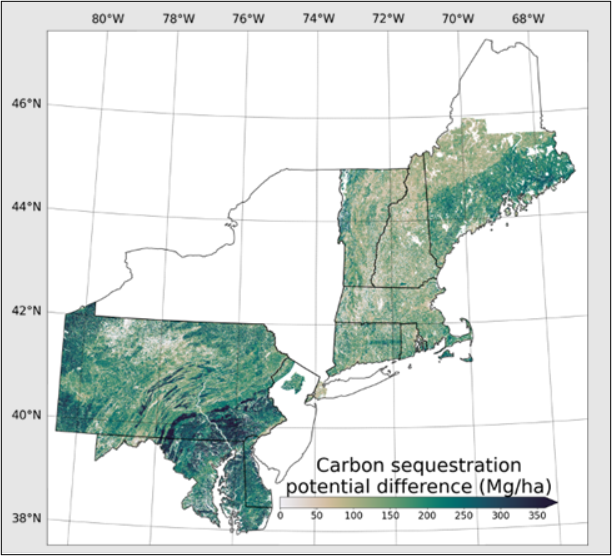The ORNL DAAC recently released the following dataset from the Carbon Monitoring Systems (CMS) project by Ma, L., et al., (2022):
Forest Aboveground Biomass and Carbon Sequestration Potential, Northeastern USA
This dataset provides 90 m estimates of forest aboveground biomass (Mg/ha) for nominal 2011 and projections of carbon sequestration potential for 11 states in the Regional Greenhouse Gas Initiative (RGGI) domain. The RGGI is a cooperative, market-based effort among States in the eastern United States. Estimated biomass and sequestration potential were computed using the Ecosystem Demography (ED) model. The ED Model integrates several key data including climate variables from Daymet and MERRA2 products; physical soil and hydraulic properties from Probabilistic Remapping of SSURGO (POLARIS) and CONUS-SOIL; land cover characteristics from airborne lidar, the National Agriculture Imagery Program (NAIP), and the National Land Cover Database (NLCD); and vegetation parameters from the Forest Inventory and Analysis (FIA) Program.
The NASA CMS program is designed to make significant contributions in characterizing, quantifying, understanding, and predicting the evolution of global carbon sources and sinks through improved monitoring of carbon stocks and fluxes. The System uses NASA satellite observations and modeling/analysis capabilities to establish the accuracy, quantitative uncertainties, and utility of products for supporting national and international policy, regulatory, and management activities. CMS data products are designed to inform near-term policy development and planning.
Additional data from Carbon Monitoring System (CMS) project and other relevant links can be found on the ORNL DAAC's CMS Project Page.
Citation: Ma, L., G.C. Hurtt, H. Tang, R. Lamb, E. Campbell, R.O. Dubayah, M. Guy, W. Huang, J. Lu, A. Rudee, Q. Shen, C.E. Silva, and A.J. Lister. 2022. Forest Aboveground Biomass and Carbon Sequestration Potential, Northeastern USA. ORNL DAAC, Oak Ridge, Tennessee, USA. https://doi.org/10.3334/ORNLDAAC/1922

